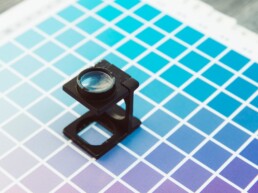Simplifying the Hunt with User Interface
Consistency and predictability go a long way when establishing a positive brand association, and that concept applies fully to user interface design. They may not be aware of it, but users who have become familiar with specific elements in design behave in a certain way; depending on the intended result, designers must be vigilant to optimize their interface for user satisfaction.
Even items as seemingly simple as control buttons, navigational details, and toolbars affect the impression made with site interaction. Going deeper into each component (for example), there are different ways to structure basic elements like checkboxes – implementing checklists is best when the boxes are placed vertically, drawing the eye to its natural scrolling motion that has become prevalent throughout web design (in this case, users are already familiar with the parallax scrolling phenomenon that has swept through design – knowing that fact and structuring the user interface accordingly creates a smooth user experience).
Ensuring that a web interface is easy to use and intuitive for visitors is key – elements like a search field make your website smoothly navigable and organized. It allows users to enter a keyword or query and submit it to the index, promptly receiving the most useful and relevant results. Most websites have placed their search bar near the top of the page; by following that “template,” the user experience is simplified and quickened (no time is wasted on a hunt for a simple tool).
Tags allow users to identify distinct content or items used in blogging and throughout websites, narrowing down the search process. For instance, retail (or e-commerce) websites have hundreds upon hundreds of items. With the tagging option, users can zero in on the wanted items quickly and efficiently without needless and tedious scrolling.
Users can also refine their search pool by using sliders and changing the parameters (e.g., based on price point, size, brand, etc.) All of these elements are designed to create a more efficient and pleasant UX – if a user were to spend more time than necessary searching for an item, he or she would quickly give up and move on to a website that could quickly provide a solution.
Interaction with the user interface design should always be natural, and the navigational elements and call-for-action should make sense immediately. Branding elements such as colors, shapes and fonts should be consistent throughout – this not only strengthens the brand identity but also gives the user a clear idea of what they can interact with.
Next Item
Power Your Brand with Color

The Art and Science of UI Design: A Guide to Effective Interface Creation
User Interface (UI) design is a multifaceted discipline that focuses on creating visually appealing, easy-to-use, and efficient interfaces for digital products. With technology's rapid evolution and user expectations constantly shifting, UI…
The Future of User Experience
A Comprehensive Guide to Enhancing User Engagement through Design Language and Interactive Design The landscape of digital design is rapidly evolving, with new technologies and methodologies emerging every day with significant considerations…
The Use of Color in User Interface Design
Color is a crucial element of user interface design, not only shaping the mood and emotional resonance but also significantly affecting usability. An interface that employs well-thought-out color schemes can enhance user experience by improving…


